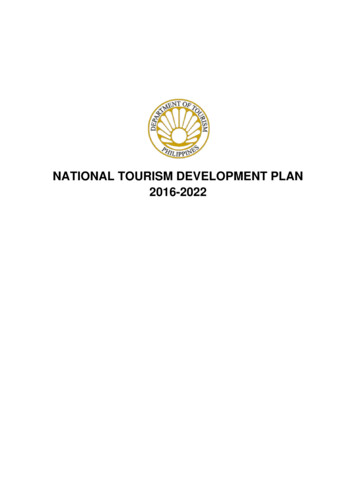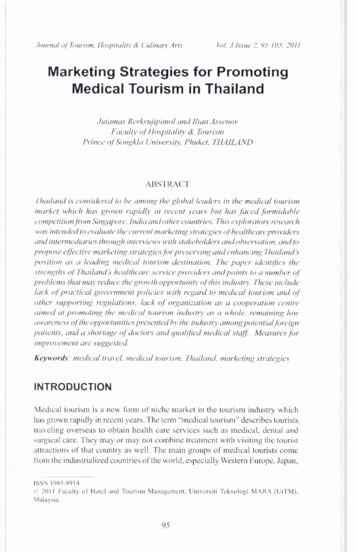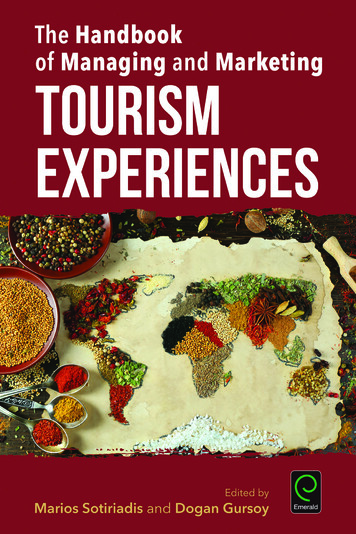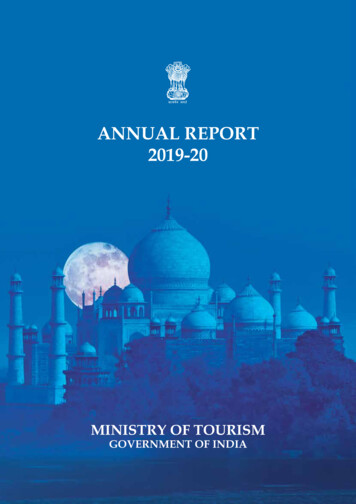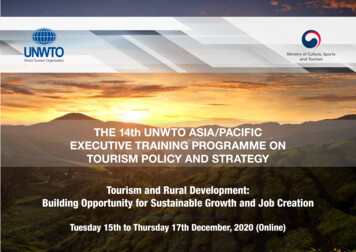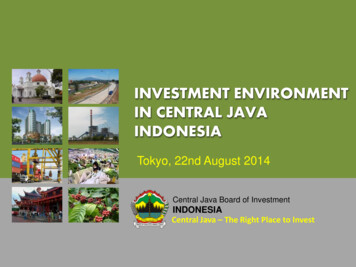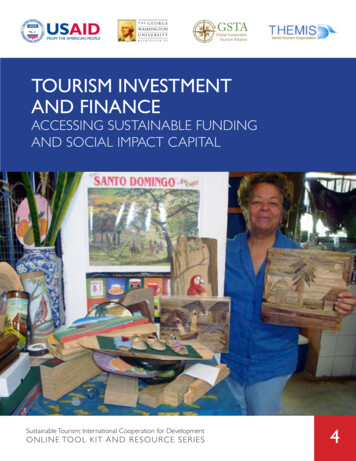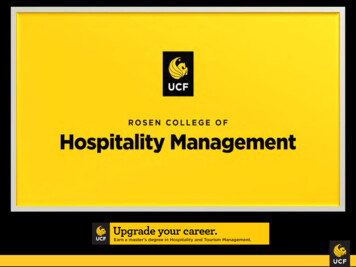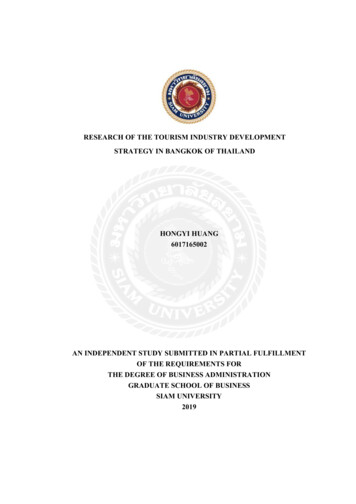
Transcription
RESEARCH OF THE TOURISM INDUSTRY DEVELOPMENTSTRATEGY IN BANGKOK OF THAILANDHONGYI HUANG6017165002AN INDEPENDENT STUDY SUBMITTED IN PARTIAL FULFILLMENTOF THE REQUIREMENTS FORTHE DEGREE OF BUSINESS ADMINISTRATIONGRADUATE SCHOOL OF BUSINESSSIAM UNIVERSITY2019
ACKNOWLEDGMENTTwo years of graduate study abroad is coming to an end. Looking back at justarrived in Thailand and helpless. Now I have grown up a lot. Although there are manyproblems and difficulties in study and life abroad, I am very lucky to have such aprecious experience. After nearly a year of writing, I finally finished my master's thesis.First of all, I would like to thank my advisor, Professor Dr. Chao Qiu. In my thesiswriting process of comprehensive guidance. This paper is under the careful guidance ofteacher ding gradually completed. The whole process from topic selection, openingreport, outline determination and research scheme design to thesis writing, revision andthe final draft is completed under the comprehensive guidance and patient modificationof Professor Dr. Chao Qiu, which embodies the great efforts of Professor Dr. Chao Qiu.I sincerely thank Professor Dr. Chao Qiu!Secondly, I would like to thank the faculty of the school of international businessadministration at Siam University. I would like to thank my teachers for giving meprofessional knowledge and knowledge sharing in class. No matter in study or life, theteacher has given me a lot of help. I also received great help and support from myclassmates, who became my good teachers and helpful friends during the learningprocess. We studied and lived together, which made my study in Bangkok full of fun. Ilearned a lot from them. In addition, I would like to express my gratitude to my belovedparents who have brought me up so hard over the years. My parents' consistent supportenabled me to successfully complete my studies.Although my postgraduate life is coming to an end and my thesis writing has cometo an end, my knowledge and ability are limited, and I may have many shortcomings inthe research of this topic. I sincerely hope that all the experts and teachers can give mesome criticisms and corrections, so as to facilitate my growth and progress. In thisregard, I will continue to learn, positive and enterprising, struggle. Thank you verymuch.I
CONTENTSABSTRACT. IABSTRACT(CHINESE) . IIIACKNOWLEDGMENT . IVCONTENTS . I1. INTRODUCTION . 1Background . 1Research Significance . 2Purpose of the Research. 3Research Content and Structure. 31.4.1 Research Content . 31.4.2 Structure Arrangement . 32. LITERATURE REVIEW . 5Definition Of Tourism . 5International Research Status . 82.2.1 Thai Research . 82.2.2 Chinese Research . 92.2.3 Other Countries . 9Sustainable Development Theory . 10SWOT Analysis Model .113. RESEARCH METHODS . 12Resource of Research material . 123.1.1 Overview Of The Current Situation Of World Tourism Development . 123.1.2 Characteristics and data analysis of tourism development in Thailand . 143.1.3 Analysis Of Main Indicators Of Bangkok's Tourism Development . 19Mainly Specific Methods . 273.2.1 Literature research combined with practical observation . 283.2.2 Qualitative method. 294. PROLONG ANALYSIS ON DEVELOPMENTOD THAILAND TOURISM . 30Case Description . 错误!未定义书签。Analysis Of Existing Problems . 314.2.14.2.24.2.34.2.44.2.5Transport problems and lack of travel standards . 31Travel Safety Problems And Fraudulent Behaviors . 32Lack Of Sense Of Security Caused By Political Factors . 33Tourist attractions lack effective management . 34Lack Of Standardized Tourism Services And Legal Pricing . 35SWOT Analysis Of Bangkok's Tourism Development. 374.3.1 Strengths(S) . 37I
4.3.2 Weakness (W) . 424.3.3 Opportunity (O) . 444.3.4 Threat (T) . 46Suggestions For The Development Of Tourism In The Valley Of Thailand . 494.4.14.4.24.4.34.4.44.4.54.4.64.4.7Improvement Measures To Promote Valley Traffic System . 49Rational Measures To Improve Security In Bangkok . 50Build Trust And Promote The Development Of Tourism . 51establish sustainable development of tourist attractions . 52Increase Urban Green Area And Improve Environmental Problems. 53improve staff quality and meet international standards . 54Promote Relevant Departments To Actively Participate In Tourism ResourceManagement . 555. RESEARCH SUMMARY AND PROSPECT . 57Research Conclusions . 57Research Limitations and Prospects . 58REFERENCES . 60II
Table CatalogTable 3-1 Data of Thailand industry development between 2003-2013 .16Table 3-2 The number of tourists in Bangkok between Years 2009-2015 .24Table 3-3 The average days of tourists who stayed in Bangkok between years 2009-2015 .25Table 3-4 The average cost of tourists in Bangkok between years 2009-2015.25Table 3-5 The tourism revenue in Bangkok between years 2009-2015 .26Table 3-6 The number of tourists who stayed in Bangkok between years 2009-2015 .27III
RESEARCH ON DEVELOPMENT STRATEGY OF THAILANDBANGKOK TOURISM1. INTRODUCTIONBackgroundTourism has become one of the fastest growing sectors of the global economy.Globally including Thailand, tourism generates income and employment thus it isregarded as one of the most dynamic devices in the country’s economic development.In realizing the importance of tourism industry which is experiencing prosperity, theRoyal Thai Government, Ministry of Tourism and Sports, Tourism Authority ofThailand as well as local private and public agencies all participate in tourism bothpolicy and practice(Chaiprasit, Jariangprasert, Chomphunut, Naparat, &Jaturapataraporn, 2011). Public agencies all participate in tourism both policy andpractice Therefore, more and more countries have begun to strengthen thecompetitiveness of the tourism industry and compete for the share of the world tourismmarket. The development of tourism has been integrated into important projects ofnational development to a certain extent. When countries formulate nationaldevelopment strategies, tourism has become a significant part of economic development.If the country has a clear national development strategy, a strong economic foundation,good infrastructures, abundant natural resources, and tourism talents, then these factorswill create a country’s competitive advantage and a stable increase of tourismdevelopment.Thailand is located in the south-central part of Asia’s Indo-China Peninsula, andBangkok is the seat of the central and provincial governments. Thailand is the 51stlargest country in the world with a land area around 514,000 square kilometers.Thailand's population ranks 20th in the world and is about 69 million people. Everyyear, there are no less than 20 million travel enthusiasts coming, and the nationaltourism income exceeds 1 trillion baht (Yang Huitian, 2017). Thailand is a traditionaltourist country with beautiful natural scenery, abundant cultural landscape, rich folkcustoms, and affluent tourism resources. It is believed that Bangkok has a large numberof tourism resources, but commodity enterprises are generally very small, withoutI
efficient and high-quality services. Especially in the sense of service, virtue, and ethics(Rapeepan Tonghoand and other people, 2006).Research SignificanceTourism is Thailand’s main economic driver, with an average annual growth rateof 12% (2009-2014), which is higher than Thailand's overall economic growth rate(Zhao Rui, 2018). At the same time, it has driven the employment rate, the serviceindustry and other related industries distributed in various fields, and the people invarious regions to move towards economic prosperity, including the construction of theentire public utilities and facilities. Tourism is also an important tool to improve thequality of people's lives, promote social development, and help people understand andlearn about the culture of various countries. In addition, it is also beneficial in otheraspects, such as the spread of Thai culture, art, and history. More and more people loveThailand, and it will also drive entering and investment of foreign business. So tourismis one of Thailand's important industries.The rapid development of tourism will also expose many problems in the city, suchas traffic congestion, tourism safety, and various pollution problems. These problemswill make tourists feel disgusted and lack of interests and sense of security for the tripto Bangkok, so they will no longer want to travel to Bangkok. In view of the overallimage of Bangkok tourism, the author hopes to find out the best strategies andsuggestions for improvement through the research and analysis of this thesis, so thatBangkok tourism can master better management measures and develop into a level ofinternational standard tourism city. What’s more, the tourism image of Bangkok alsorepresents the image of Thailand. If the number of tourists coming to Bangkok hasincreased, the number of tourists going to other cities in Thailand will also increase. Atpresent, the world is moving towards an aging society. And it tends to increase. The datafrom 2010 showed that the elderly accounted for 15.2%, and 16.9% in 2015, showingan increasing trend. Provision of safety protection for senior tourists, physicalimprovement of tourist destinations, development of easy and convenient accessibility,support for accommodation and attractions, and facility improvement for senior touristsshould be taken into consideration if Thailand wants to attract more senior tourists fromEuropean countries. (Esichaikul, 2012)2
Purpose of the ResearchMy research topic is Study on Tourism Development Strategy in Bangkok,Thailand, will focus on this paper studies the current situation of urban tourismdevelopment and puts forward the existing problems in the process of urban tourismdevelopment,find out reasonable improvement measures. As the number of touristsvisiting Thailand has increased year by year, the development of tourism has broughthuge foreign exchange earnings to Thailand. In addition, Bangkok City is the capital ofThailand and is the main tourist city of choice for foreign tourists. In addition to learningmore about the tourism background of Bangkok, Thailand, this study also focuses oncurrent and future tourism developments and the growth in the number of overseasvisitors. Through the above survey, this study researches the development problems oftourism in Bangkok and its problems in the long-term development of tourism.Research Content and Structure1.4.1 Research ContentResearch target, this paper first through Bangkok, Thailand tourism industrycurrent situation, understand the Bangkok environment and the development of tourismpotential, and secondly by SWOT analysis from the strengths, weaknesses,opportunities and threats four aspects in detail analysis of Bangkok tourismdevelopment present situation and existing problems, finally put forward thecorresponding countermeasures and development strategy, try to improve and thedevelopment of tourism in Bangkok, Thailand and improvement measures are putforward.1.4.2Structure ArrangementThis article was divided into five chapters:The first chapter was the introduction. Mainly analyzing the research background,research purpose, research significance, domestic and foreign research status, researchcontent and methods of tourism development in Bangkok, Thailand.The second chapter is literature review. This chapter mainly introduces the relatedtheories of tourism development, sustainable development and SWOT analysis model,which lays a theoretical foundation for this study.3
The third chapter introduces the development process and environment analysis oftourism in Bangkok, including the general situation of Thailand, the tourism in Bangkok,the current situation of world tourism, the development trend of tourism in Thailand andthe development of tourism in Bangkok.The fourth chapter is through the analysis of Bangkok tourism development statusanalysis and analysis of the existing problems. SWOT analysis of Bangkok tourismdevelopment.The fifth chapter was the conclusion and prospect. This chapter summarized theresearch results of this paper, analyzed the innovation and limitations of this research,and finally looked forward to future research.4
2.LITERATURE REVIEWDefinition Of TourismThe word Tour comes from the Latin "torture" and the Greek "tornos", with themeaning of "circle or circle"; Movement around a central point or axis. The meaninghas changed to "order" in modern English. The suffix ism is defined as "an act or process;the suffix "ist" refers to "a person who is engaged in a particular activity". The root ofthe word "tour" is connected with the suffix "ism" and "ist", which means to move in acircular path. Therefore, tourism refers to a kind of reciprocating journey, that is, anactivity of returning to the starting point after leaving. Those who finish the trip are alsocalled "tourists".In Webster's dictionary, travel is defined as "the journey of a person back to wherethey came from; A trip was taken for business, pleasure, or educational purposes,usually with a planned itinerary to different places. Tourists are defined as "people whotravel for the purpose of entertainment".According to the most commonly used concept in the study of the tourism industry,tourism industry refers to the collection of industries involved in various activities ofpeople in the process of tourism. To put it simply, the tourism industry contains the sixelements we often say: food, housing, transportation, travel, shopping, andentertainment. But its formation process has experienced half a century, agglomeratedthe painstaking efforts of several generations, and concentrated the wisdom ofthousands of tourism workers. Understanding its formation process is conducive tobetter service for tourists in the actual tour guide work. The finding that showed thediversity of tourist destinations (many kinds of tourist destinations) ranked as the lowestimportance among the ten destination factors implied that Thailand may now becompeting with new entrants of tourist destinations in regional tourism industry such asVietnam and Myanmar, and other countries such as Malaysia with its emerging tourismproducts that eventually increase its tourism diversity (Yiamjanya & Wongleedee, 2014).Definition of international organizationDefinition of international touristsDuring the armistice of the two world wars, the world's international tourismrevenue grew rapidly, so there was an urgent statistical need for a more accuratedefinition. At an international BBS conference held in 1936, the committee of statisticalexperts of national union first proposed that "foreign tourists refer to people who leave1
their usual residence to travel to other countries for at least 24 hours". In 1945, theUnited Nations (which replaced the original League of Nations) endorsed the definitionbut added the "maximum stay of six months" limit.1963 the United Nations international conference on tourism opened in Rome. Theconference was sponsored by the then international federation of official tourismorganizations (now the world tourism organization). The Congress proposed the use ofthe new term "tourist", which would define a tourist as "a person who leaves his countryof habitual residence to go to another country and whose main purpose is not to obtainincome in the country he visits". Tourists include two different kinds of travelers:tourists and short-term tourists. Tourists refer to temporary tourists who stay for morethan 24 hours in the country of the visit for purposes of leisure, business, family affairs,missions or meetings; Short-term tourists refer to temporary tourists (including cruisetourists) who stay at the destination for less than 24 hours and do not stay overnight.1967 the United Nations statistical commission, meeting in Geneva, adopted thedefinition of the Rome conference. Tourism policy is an area which to date, has not beengreatly intervened into by executive decisions. One major reason for this is the smallgovernment budget involved. Much of the tourism budget is utilized for promotionalpurposes overseas. This occurred because higher level government officials incorrectlyperceived tourism in Thailand as suffering from demand problems. In the new tourismmaster plan approved by the Cabinet in 1997, budget requests for the rehabilitation oftourism sites in the provinces are requested. However, owing to budget constraints, thebudget package has been postponed until the present fiscal situation improves. (Kaosaard, 1998)The legal status of international touristsDifferent from domestic tourism, international tourism involves the transnationalflow of tourists of different nationalities. Although the transnational flow of touristsprovides a driving force for the development of the world economy and the economy ofvarious countries, based on the requirements of national sovereignty and nationalsecurity, each country has set up an entry and exit management system to regulate theinternational tourism of tourists. For a country, restrictions on international travelersinclude entry and exit.International tourists in the country of destination are generally regarded asforeigners, therefore, international tourist treatment standards usually follow theinternational law on the treatment of foreigners in general principles, mainly national2
treatment and MFN treatment. However, what treatment and rights a state should grantto foreigners in its territory are generally regulated by the domestic law of the countryof destination. For example, article 23 of the tourism law of Ukraine stipulates the legalstatus of foreign tourists. The legal status of foreign tourists in Ukraine is regulated bythe law on the legal status of foreigners of Ukraine and other Ukrainian laws andregulations, as well as existing international treaties and intergovernmental agreementsto which Ukraine is a party.The principle of international tourist treatment: national treatment. Nationaltreatment is one country by the provisions of laws or treaties, treat their citizens in thesame way to treat foreigners, will enjoy the rights of citizens, foreigners also likewisegive within their borders, within their borders foreigners and domestic people enjoyequal treatment, its aim is to guarantee within and between foreigners have equal status,there is no discrimination. National treatment applies to the field of tourism. It meansthat foreign tourists entering the territory of a country have the same treatment asdomestic tourists, enjoy the same tourism rights and undertake correspondingobligations. Foreign tourists and domestic tourists, shall enjoy the right to travelsightseeing, tourism services know right, tourist service options, safety and health rights,supervision and rights such as right, at the same time in the tourism activities shallcomply with the national laws and regulations, and protect the local tourist resources,respect the local ethnic customs and religious beliefs, etc. In addition, according to theprevailing principle of conditional national treatment, a country usually has the right tostipulate exceptions to national treatment on the grounds of national security, publicorder and social and public interests, such as restricting the freedom of travel of foreigntourists under emergencies such as war or martial law, which does not violate theprinciple of national treatment. Most of these studies attempt or propose to segmentcustomers in terms of their search behavior. Further, most of these studies look at searchbehavior in the context of B2C sites that sell consumer goods like Groceries. Tourismbeing an information good where, at the time of purchase, the customer is only providedwith information about the product and also, since tourism is typically a high-value itemit can be safely surmised that clickstream based segmentation alone will not be able tocompletely describe customer behavior (Hoontrakul & Sahadev, 2008).3
International Research Status1.2.1 Thai ResearchBoonlert Jitteangwattana (2005) found that Bangkok, as the capital of Thailand,ranked first in the world in terms of tourism development for many years through thesurvey and research of tourism magazines. Foreign tourists think that Bangkok has avery important unique feature, which is the perfect combination of modern architectureand Thai architecture, to create a perfect balance between modern technology andtraditional culture. To westerners, the most surprising thing is that there are manytemples in the city center. The way of life of people in Bangkok is different from othercities in Thailand except maintaining the traditional characteristics. Therefore, goodpolicies and development strategies promote the characteristics of Bangkok's tourismindustry, and the development strategy of Bangkok's tourism industry should bedifferent from other cities. National tourism promotion strategies cannot be used todevelop Bangkok's tourism industry.Rapeepan Tonghoand and other people (2006) believed that Bangkok has a largenumber of tourism resources, but commodity enterprises are generally very small,without efficient and high-quality services. Especially in the sense of service, virtue,and ethics. In the author's opinion, the security issue has always been a criticism ofBangkok's over-development of tourism. If the security issue is not properly solved,Thailand's tourism will eventually go to ruin. Therefore, the important way of tourismpromotion, first of all, should pay attention to the development potential of enterprises,especially the form of participation between employees and owners, in the service oftourists to deal with the problem, maintain frequent communication and informationexchange. Fair wage treatment for employees, so as to ensure that each employee canbring tourists a good travel experience. Tourism has become one of the fastest growingsectors of the global economy. Globally including Thailand, tourism generates incomeand employment thus it is regarded as one of the most dynamic devices in the Countryyears economic development. In realizing the importance of tourism industry which isexperiencing prosperity, the Royal Thai Government, Ministry of Tourism and Sports,Tourism Authority of Thailand as well as local private and public agencies all participatein tourism both policy and practice(Chaiprasit, Jariangprasert, Chomphunut, Naparat,& Jaturapataraporn, 2011).4
1.2.2Chinese ResearchCHEN WEINA (2011) believes that Thailand is a traditional tourism country witha unique geographical location. It boasts magnificent natural landscape, rich culturalresources, splendid Buddhist temples, magnificent royal palaces, kind-hearted andhonest folk customs, as well as rolling mountains and white silvery beaches. Based onits rich resource advantages, Thailand's tourism industry has developed rapidly andbecome the pillar industry of the country through the joint efforts of generations oftourists and the good grasp of historical opportunities. Thailand's tourism industry hasalways played an important role in Thailand's national economy, but in recent years,Thailand's political instability and the impact of the world economic crisis, but thetourism industry has caused a great impact backZHU WEI (2015) SWOT strategy analysis method was used to analyze the internaladvantages, disadvantages and external opportunities and threats closely related to theresearch object based on the situation analysis in the external competition environmentand competition conditions. It was listed one by one through investigation and arrangedin matrix form. They with the thought of system analysis, an analysis of various factorsmatch each other from a series of corresponding conclusions, showing their facesopportunities and challenges, thus further in strategic and tactical two levels to adjustthe allocation of resources, to seek new development to ensure sustained competitiveadvantage to achieve organizational goals1.2.3Other CountriesAccording to Susan Briggs (1997), the competitive environment in the tourismmarket of all capitals is fierce at present. It was further explained that the convenienceof global communications contributed to the success of tourism in most regions atpresent. By establishing the urban landscape tourism flow, the cultural andentertainment tourism flow can be established at the same time. The most obviousexample is South Korea, where many tourists visit because of its unique national cultureand entertainment rather than because of its architectural style. Even London needs touse the experience of launching the Olympic Games in 2012 to attract overseas visitors.This shows that various tourism modes and approaches are very important for thegrowth of the number of touristsGodfrey, K& Clarke, J (2000) believed that the fundamental way to promote thetourism of foreign tourists was to emphasize the importance of tourism development.5
This issue has received more attention from researchers. We believe that tourismresources can be divided into physical characteristics and local cultural characteristicsaccording to their meanings. To a large extent, these meanings are the motivation fortourists to choose travel. For example, the precipitous environment of the primevalforest, if the landscape is beautiful, can have a great advantage to attract tourists to travel,but also must have other elements, such as goods and services, reasonable price, thesafety of tourist attractions. The future direction of tourism development depends on thepreferences of tourists.Sustainable Development TheoryThe theory of sustainable development is a new development theory formed in thelate 1980s and early 1990s. As soon as it came into being, it has been widely recognizedby people from all walks of life all over the wo
The first chapter was the introduction. Mainly analyzing the research background, research purpose, research significance, domestic and foreign research status, research content and methods of tourism development in Bangkok, Thailand. The second chapter is literature review. This chapter mainly introduces the related


